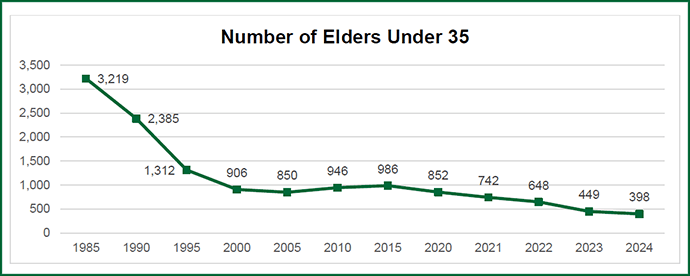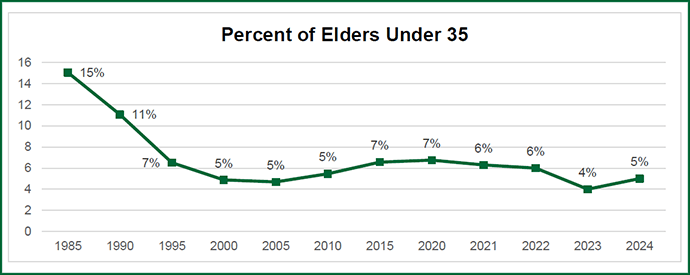Key Points:
- In its latest study of United Methodist clergy, the Lewis Center for Church Leadership discusses the impact of church departures.
- Disaffiliations have led to reductions in the ranks of both older and younger elders.
- The report also identifies conferences that continue to have a relatively high percentage of younger clergy.
A season of church disaffiliations has taken its toll on the number and age distribution of United Methodist clergy in the U.S.
That’s the conclusion of the Lewis Center for Church Leadership in this year’s report on “Clergy Age Trends in The United Methodist Church.”
While stressing that more data is needed, the Lewis Center reported that United Methodist disaffiliation trends indicate U.S. clergy losses were highest among licensed local pastors and least among deacons. Church departures also contributed to reductions in the ranks of both the oldest and youngest elders — seminary-educated ordained clergy who historically have filled most of the denomination’s pulpits.
“Among elders, it appears that losses occurred more among older (55-72) elders and young elders (under 35),” the report said.

The Lewis Center — based at United Methodist-related Wesley Theological Seminary in Washington — has been tracking United Methodist clergy age trends since 2006 with a particular focus on young elders. This year sets a new record low for the fewest elders under the age of 35.
This year’s young U.S. elders number 398, a loss of 51 from last year’s previous record-low number. That total continues an eight-year slide, though the drop since last year was only a fraction of that between 2022 and 2023.
Because the overall number of active U.S. elders of all ages is decreasing, young elders actually now constitute a larger percentage of active elders — about 5% in 2024, compared to 4% last year. The percentage of middle-aged elders, defined as ages 35 to 54, also increased to 45%, from 44% in 2023.
In contrast, the portion of active elders who are 55 and older has dipped from 52% to about half.
In total, The United Methodist Church has 8,505 elders in the U.S. — down more than 1,500 from last year.
The overall trend doesn’t surprise the Rev. Lovett H. Weems Jr., senior consultant of the Lewis Center for Church Leadership and the project director.
“Unfortunately, it’s about what I expected,” he said, “and I think we’ve got another year that will be disaffiliation-affected.”
On behalf of the Lewis Center, Weems also has been tracking church exits from The United Methodist Church in the U.S.

About a quarter of the denomination’s U.S. churches have left under a disaffiliation policy instituted by the 2019 special General Conference amid intensifying debates about LGBTQ inclusion. The policy allowed congregations to leave with property if they met certain financial and procedural requirements. Most of the congregations that ended up using the policy tended to support bans on same-sex weddings and gay clergy.
The church-exit policy expired at the end of 2023. This year’s General Conference — the denomination’s top legislative assembly — removed the provision altogether from church law as well as longtime denomination-wide restrictions around LGBTQ inclusion.
However, some U.S. conferences — regional bodies consisting of multiple congregations and ministries — have continued to allow churches to leave with property under another church-law provision.
More on report
The Lewis Center for Church Leadership report on clergy trends listed the conferences that ranked in the top in terms of their percentage of elders under age 35.
They are:
- Texas (No. 1 in 2023, 2020-2019, 2016-2014, 2012) and Central Texas (No. 1 for the first time)
- North Carolina
- North Texas (No. 1 in 2022 and 2021)
- Great Plains (new to the Top Ten this year)
- Florida (new to the Top Ten)
- Louisiana
- North Alabama (new to the Top Ten this year)
- Pacific Northwest
- Dakotas and Alabama-West Florida (tie)
The Virginia Conference has the largest total number of young elders with 24.
Read the Lewis Center report.
Read the Rev. Lovett H. Weems Jr.’s essay: Is there an ideal age for clergy?
In the meantime, Weems has been trying to determine the impact of disaffiliations by comparing clergy numbers and age trends from 2019 to 2024 with similar blocks of years in the past.
The clergy age data largely comes from Wespath, the denomination’s pension and retirement-benefits agency. While not all U.S. United Methodist clergy are in the denominational retirement system, the Lewis Center’s report notes that most are. However, the Lewis Center does not have firm numbers on the clergy who have withdrawn from the denomination.
What the center can measure is that after years of modest gains since a low point in 2005, the number of elders under the age of 35 began to slide in 2017 amid growing discussions of possible denominational separation. Three years later, the ranks of young elders began a major decline. Since 2019, when denominational divisions deepened still further and disaffiliations began, the number of under-35 elders has plummeted by 63%.
The center also reports the overall reduction in clergy during the same time period.
Weems pointed out that multiple variables can contribute to the reduction in clergy, including older clergy retiring. He also stressed that the pastors of churches that disaffiliated and pastors who withdrew are not necessarily the same people.
Still, he added, “it’s remarkably consistent in terms of clergy leaving and churches leaving because it appears that often the clergy were either behind the disaffiliation, a chief supporter of it or at least were not working against it.”
As evidence of the correlation between church and clergy exits, Weems observed that bishops and their cabinets do not appear to be struggling with substantially more clergy than available church appointments.
Despite the turbulent times, the Lewis Center report also points to conferences that have nurtured a relatively high percentage of elders under 35.
The Texas and Central Texas conferences, despite both being hard hit by disaffiliations, tied this year for having the highest proportion. Young elders make up about 10% of each conference’s elder ranks.
This marks the first time Central Texas has led the Lewis Center list. It is a bittersweet distinction for a conference that is in the process of unifying with its neighbors to form the new Horizon Texas Conference starting in January.
The Texas Conference, however, has repeatedly led U.S. conferences in its proportion of young elders — taking the top spot in 2012, 2014-2016, 2019-2020 and last year as well.
The Rev. Madison Garcia-Tabor, a 28-year-old elder who grew up and still serves in the conference, attributes that consistency to the leadership of now-retired Bishop Janice Riggle Huie. During her tenure in the conference from 2004 to 2016, Huie made leadership development a priority, including helping to launch the Texas Youth Academy for teens to explore their ministry call.
Garcia-Tabor attended the youth academy as a high school student. She said her time at the two-week theological camp had a big impact on her being able to flesh out her sense that she could help people experience the grace of God. When she was a student at Texas A&M University-Commerce, the conference also made it possible for Garcia-Tabor to serve summer internships at local churches.
“It was during those two summers where I was on the ground, working with a pastor day in and day out, that I finally was able to kind of take a hold of my call and finally say, ‘OK, I can do this. I’m capable of it, and I’m called to do it,’” she said. She is now pastor of St. John’s United Methodist Church in Rockdale, Texas.
“If I hadn’t had those tools, I really don’t think I would be ordained right now. I think I would be eventually, but it just would be a lot later.”
Still, as a student at Southern Methodist University’s Perkins School of Theology in Dallas, she could see how the disaffiliations hurt young clergy recruitment in her home conference.
“I had friends from the Texas Annual Conference who felt a call to working in ministry,” she said. “But in the midst of everything, they transferred their membership to other conferences because they didn’t feel comfortable in the Texas Conference. That was really disheartening.”
Subscribe to our
e-newsletter
Weems said the drop in younger elders may result less directly from clergy withdrawals but a reduction in people actually moving through the ordination process in the first place because of the tumult.
“I’m thinking that those reduced numbers may come from some of the same dynamics that seem to be taking place among young elders after 2016 and after and then around 2019,” Weems said.
Both Weems and Garcia-Tabor see hope for U.S. conferences to focus on drawing young clergy again, now that The United Methodist Church is moving beyond a time of uncertainty about its future.
The recent General Conference, he said, has created “a new space of openness that is refreshing and may very well help with younger clergy.”
Garcia-Tabor shared a similar sentiment, crediting Bishop Cynthia Fierro Harvey — who now leads the Texas and Rio Texas conferences — for a renewed focus on young clergy development.
“I feel hope for the first time in a bit,” Garcia-Tabor said, “and I know that she has a heart for young clergy, and so I am very excited to see where she leads us as a conference.”
Hahn is assistant news editor for UM News. Contact her at (615) 742-5470 or newsdesk@umnews.org. To read more United Methodist news, subscribe to the free Daily or Friday Digests



